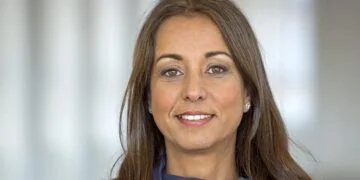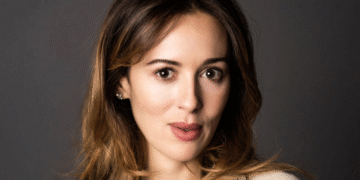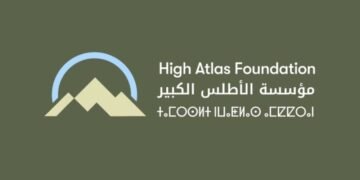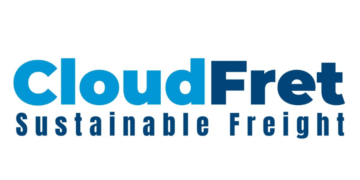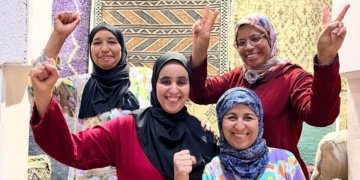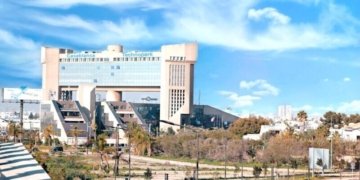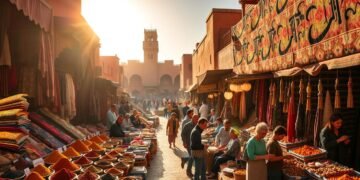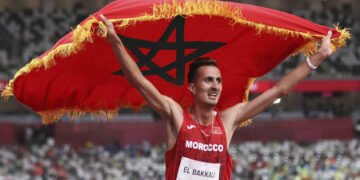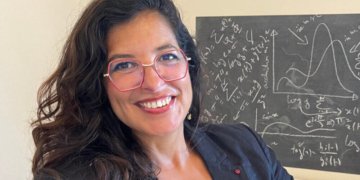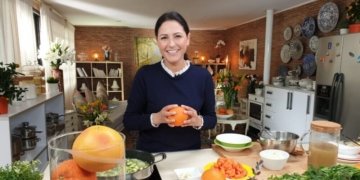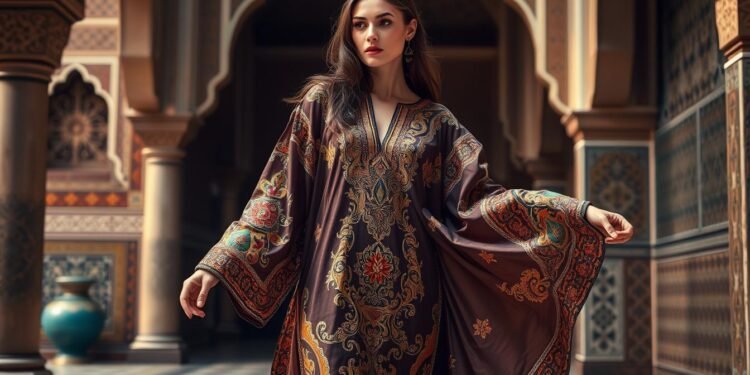Step into the world of Moroccan fashion and you’ll find a standout garment – the Moroccan kaftan. This stunning piece has been part of Moroccan culture for centuries, dating back to the 1500s. Its flowing silhouette and exquisite details capture the essence of Moroccan style.
Crafted from luxurious fabrics like silk, satin, or velvet, these dresses are adorned with breathtaking embroidery, sparkling beadwork, or shimmering sequins. Each region of Morocco adds its unique spin to the kaftan. This shows in the distinct embroidery styles and color palettes that reflect local traditions.
At weddings and religious festivals, the Moroccan kaftan takes center stage. Its versatility is evident, adapting from everyday wear to bridal attire with ease. To see these beautiful dresses in all their glory, visit Morocco’s vibrant markets, boutiques, and shops.
For a deeper dive into the history of Moroccan traditional dress, the Tiskiwin Museum in Marrakech is a must-visit. And if you’re in town during Caftan Fashion Week, you’ll see the latest designs from local and international designers. Fashion lovers from all over the world flock to this event.
Key Takeaways
- Moroccan kaftans have a rich history spanning over 500 years
- These dresses use high-quality fabrics and intricately embellished
- Kaftans play a significant role in Moroccan celebrations and events
- Each region in Morocco has its own unique kaftan style
- Marrakech hosts both a museum and an annual Caftan Fashion Week
- Moroccan markets offer a wide variety of kaftan options
The Rich History of Moroccan Kaftans
Moroccan kaftans have a long history in North African culture. They have changed over time, becoming a key part of Moroccan identity. The mix of Arab, Berber, and Andalusian styles has made the kaftan what we love today.
In the time of Caliph Muhammad an-Nâsir, Fez was full of weaving workshops. This showed how important textiles were in Moroccan culture. The Marinid dynasty made the kaftan even more special by sending them to Ottoman sultans. They called them “Fas Kaftanlar” in honor of Fez.
The Saadian era was a big change for the kaftan. Women started wearing them, making them more feminine. By the 19th century, the kaftan was only for women in Morocco. Now, designers mix old and new styles, keeping the kaftan fresh.
Moroccan kaftans are loved all over the world. They’re not just for the Maghreb and Middle East anymore. Europe and other places love them too. The kaftan’s beauty and history keep it a favorite in fashion.
Understanding the Moroccan Kaftan
The Moroccan kaftan is a symbol of elegance and cultural heritage. It has evolved over centuries, keeping its essence while adapting to new tastes.
Defining Features of a Moroccan Kaftan
A Moroccan kaftan is loose-fitting and floor-length, with long sleeves. It often has detailed embroidery, making it visually stunning. Each region in Morocco has its own style.
For example, the Fassi Kaftan from Fez is famous for its beautiful embroidery and bright colors.
Traditional Materials Used
Craftsmen use luxurious fabrics for Moroccan kaftans. Silk, velvet, and satin are favorites, making the garment elegant. The Khrib kaftan, made by the Bencherif family in Fez, was known for its detailed brocade and yellow color with embroidered roses.
Symbolism and Cultural Significance
The Moroccan embroidered caftan has deep cultural meaning. It’s worn for special occasions and ceremonies, showing modesty, elegance, and pride. The Takchita, a two-piece ensemble, is loved for big celebrations.
Today, the kaftan mixes tradition with modern fashion. This keeps it exciting for people all over the world.
The Allure of Moroccan Traditional Dress
Moroccan traditional dress is known for its timeless beauty and deep cultural roots. The kaftan is a key symbol of Moroccan identity, mixing comfort with style. It has a long history, starting in ancient Persia and arriving in Morocco in the 13th century.
The craftsmanship in Moroccan traditional dress is unmatched. Skilled artisans use materials like silk, velvet, and brocade to create these works of art. Each kaftan is adorned with detailed embroidery, beadwork, and metallic threads, making it truly unique. These garments often show the wearer’s style, status, and where they come from.
Moroccan caftan design has become famous worldwide. Fashion legends like Yves Saint Laurent were inspired by these traditional outfits. They mixed Moroccan styles with modern trends. Now, kaftans are seen on red carpets and in fashion shows all over the world.
The beauty of Moroccan traditional dress is in its flexibility. Kaftans are perfect for both casual days and special events. They fit different body types and styles, keeping Moroccan fashion popular locally and globally.
Moroccan Embroidered Caftan: A Work of Art
The moroccan embroidered caftan is a symbol of Morocco’s rich artistic heritage. These garments are filled with detailed designs that grab your attention. They tell stories of tradition and culture.
Intricate Embroidery Techniques
Artisans use many methods to make these masterpieces. They use chain stitch, cross stitch, and beading in a moroccan handmade kaftan. Each stitch is placed with care, often taking weeks or months to finish a garment.
Popular Embroidery Patterns
Moroccan kaftans have a variety of eye-catching patterns. You’ll see geometric shapes, arabesque designs, and floral motifs. These patterns often have deep symbolic meanings, showing the wearer’s cultural heritage.
The Craftsmanship Behind Each Stitch
Making a moroccan embroidered caftan is a labor of love. Skilled artisans spend hours perfecting every detail. This careful work results in garments that cost between $63 and $148, showing the time and skill put into each piece.
Now, modern versions of the moroccan handmade kaftan are emerging. They feature new cuts like high-low hemlines and upturned collars. These changes mix traditional craftsmanship with modern fashion, keeping this art form alive.
Caftan vs. Kaftan: Understanding the Terminology
The terms caftan and kaftan often cause confusion. Both describe a long, flowing garment with roots in ancient Persia. This robe-like attire has spread across Central and Western Asia, becoming a staple in Moroccan fashion. The spelling difference doesn’t change the essence of the garment.
In Morocco, the caftan kaftan holds a special place. It arrived in the 16th century, quickly becoming part of the local culture. Moroccan kaftans are known for their elegant materials like silk brocade or velvet. These luxurious versions are often reserved for special occasions, worn by scholars and high-ranking officials.
The everyday Moroccan kaftan is more casual. It’s typically made from cotton or lightweight fabrics, perfect for the warm climate. These kaftans offer comfort and style for daily wear. Whether spelled caftan or kaftan, this versatile garment continues to evolve, blending traditional charm with modern fashion trends.
The Moroccan Wedding Kaftan: A Bridal Tradition
Moroccan wedding kaftans are the ultimate symbol of bridal luxury. These stunning gowns reflect Morocco’s rich cultural heritage. They are made from fine silks and velvets, adorned with goldwork embroidery and precious stones.
Brides often wear up to seven different outfits during their wedding. Each kaftan has its own story, marking different parts of the ceremony. The green or gold kaftan from the henna ceremony is special, believed to ward off evil eyes.
The main wedding event showcases the moroccan luxury caftan. These dresses are elaborate and can be quite heavy. Many brides choose to rent these due to their high cost.
Moroccan weddings last three days, though they used to last a week. The bride changes her outfit several times, each one more stunning than the last. This tradition emphasizes the bride’s importance and the joy of the occasion.
Moroccan Handmade Kaftan: Preserving Artisanal Skills
The moroccan handmade kaftan is a symbol of ancient craftsmanship. It showcases Morocco’s rich culture, made with great care. Skilled artisans spend years perfecting their craft.
The Process of Creating a Handmade Kaftan
Making a moroccan traditional dress is a detailed process. Weavers pick fine fabrics like silk and velvet. Then, dyers use traditional methods to add colors.
Embroiderers add beautiful patterns with gold threads. Tailors then put everything together, making a unique piece.
Supporting Local Artisans
Buying a moroccan handmade kaftan helps local artisans. They use old methods passed down through generations. This keeps Morocco’s textile heritage alive.
The Unique Appeal of Handcrafted Garments
Every moroccan traditional dress is special, letting wearers show their style. It combines old techniques with new designs. This makes the garments both classic and modern.
This appeal has led to collaborations with designers worldwide. It brings Moroccan fashion to the global stage.
Exploring Moroccan Caftan Designs
Moroccan caftan designs are a mix of cultural influences. They combine Berber, Arab, and Andalusian styles, making each piece unique. The 14th and 15th centuries were a peak time for Moroccan fashion.
Today, you can find simple and fancy caftans. They often have wide sleeves and side slits. Colors range from bright to soft, with metallic thread adding sparkle.
Every region in Morocco has its own caftan style. Rabat is famous for its colorful threads and flowers. Meknes and Fes love geometric shapes.
Artisans spend weeks on each embroidered caftan. Sfifa, a special finishing, adds elegance but is less common now.
Designers like Elie Saab and Yves Saint Laurent are inspired by Moroccan caftans. They show these designs on international runways. Moroccan caftans are perfect for weddings, festivals, or just everyday wear.
The Rise of Moroccan Luxury Caftans
Moroccan luxury caftans have become a big hit in the fashion world. They mix old-world craftsmanship with new designs, making them eye-catching. Prices vary, from simple ones at 50-100 Moroccan dirhams to fancy ones up to 15,000 dirhams.
High-End Materials and Embellishments
Luxury Moroccan caftans use top-notch materials like silk, velvet, and brocade. They feature detailed embroidery with gold and silver threads. Beads, sequins, and crystals add a touch of glamour.
Designer Interpretations of Traditional Styles
Designers around the world have fallen in love with the Moroccan caftan. They’ve updated classic styles with a modern twist. They keep the flowing look and detailed work but use lighter fabrics like chiffon and cotton.
This mix of old and new has made Moroccan caftans popular for many occasions and climates.
Celebrity Endorsements and Red Carpet Appearances
Stars like Oprah Winfrey, Beyoncé, and Jennifer Lopez have made Moroccan caftans famous. They’ve worn them to big events, catching the world’s attention. Their support has turned Moroccan caftans into fashion must-haves on red carpets everywhere.
Moroccan Silk Kaftan: The Epitome of Elegance
The moroccan silk kaftan is a symbol of elegance in traditional dress. It combines luxurious fabrics with expert craftsmanship, making a stunning impression. The silk fabric is lightweight and shiny, creating a beautiful shape that suits anyone.
Moroccan luxury caftans are adorned with detailed embroidery, beading, or sequins. These details turn them into masterpieces. The local artisans put their heart into every stitch, adding beauty to the silk.
These caftans are worth the investment, with prices from $63 to $148. They are perfect for weddings, religious events, or any special occasion. They offer both comfort and style, making them a valuable piece in your wardrobe.
Colors in moroccan luxury caftans hold deep meanings. Green is for religious events, yellow for celebrations. Blue means wisdom, red for power and love, and purple for wealth and royalty. This color symbolism lets the wearer express their style and personality.
The Versatility of Moroccan Cotton Kaftans
Moroccan cotton kaftans mix old-world charm with today’s comfort. They are loved for many reasons. These light clothes, rooted in Moroccan tradition, are now popular everywhere.
Everyday Wear and Comfort
Cotton kaftans are super comfy in warm weather. They breathe well, making them great for everyday use. You can find them for $63.67 to $148.6, fitting all budgets and tastes.
Modern Adaptations for a Casual Look
Today’s kaftans blend new styles with old charm. Look for shorter styles, bright colors, and simple designs. These updates make them perfect for both casual and special days.
Styling Tips for Cotton Kaftans
To make your kaftan look great, try a belt to define your waist. Or wear it over pants for a cool look. Add metallic clutches or bold jewelry for a stylish touch. The trick is to mix tradition with your own style.
FAQ
What is the significance of Moroccan kaftans?
Moroccan kaftans are elegant, flowing garments. They carry centuries of tradition and style. They symbolize modesty, elegance, and cultural pride in Moroccan society.
What is the history behind Moroccan kaftans?
Moroccan kaftans have a rich history in North African culture. Originally worn by both men and women, their design reflects Arab, Berber, and Andalusian influences. This results in a unique blend of styles and patterns.
What are the defining features of a Moroccan kaftan?
Moroccan kaftans are known for their loose-fitting, floor-length design with long sleeves. They are crafted from luxurious fabrics like silk, velvet, or cotton. They often feature detailed embroidery, beadwork, and sequins.
What materials are traditionally used for Moroccan kaftans?
Traditional Moroccan kaftans use luxurious fabrics like silk, velvet, and cotton. They are adorned with detailed embroidery, beadwork, and sequins.
What is the difference between a “caftan” and a “kaftan”?
In Morocco, “caftan” usually means a more formal, ornate version. “Kaftan” might be for everyday wear. But, the terms are often used the same way.
What makes Moroccan wedding kaftans special?
Moroccan wedding kaftans are a symbol of bridal luxury. They are made from the finest materials and decorated with goldwork embroidery and precious stones. Brides wear multiple kaftans during their wedding.
How are handmade Moroccan kaftans created?
Making a handmade Moroccan kaftan requires many skilled artisans. Weavers, dyers, embroiderers, and tailors all play a part. Each step is done by hand, keeping traditional techniques alive.
What are the popular embroidery patterns found on Moroccan caftans?
Common motifs include geometric shapes, floral designs, and calligraphy. Each stitch is carefully placed, often taking weeks or months to finish a garment.
What makes luxury Moroccan caftans unique?
Luxury Moroccan caftans use premium materials like silk, chiffon, and lace. They are often decorated with Swarovski crystals and precious metals. High-end designers create couture versions, even worn by celebrities on red carpets.
What are the benefits of Moroccan cotton kaftans?
Moroccan cotton kaftans are a casual, versatile choice for everyday wear. They are lightweight, perfect for warm climates. Modern versions have shorter lengths, brighter colors, and simpler embroidery.

